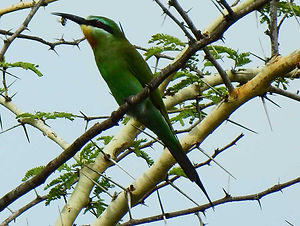
WildNothos
THE NOTHOBRANCHIUS SITE
FAVOURITE WILDLIFE SHOTS



RAPTORS
They primarily hunt and feed on vertebrates that are large relative to the hunter. Additionally, they have keen eyesight for detecting food at a distance or during flight, strong feet equipped with talons for grasping or killing prey, and powerful, curved beaks for tearing flesh. The term raptor is derived from the Latin word rapere, meaning to 'take by force'.

Tawny Eagle
Aquila rapax
Photographed: Kidepo Valley, Uganda, 2017

Tawny Eagle
Aquila rapax
Photographed: Tarangire, Tanzania, 2019

African Fish Eagle
Haliaeetus vocifer
Photographed: Shimba Hills, Kenya, 2015

Fasciated Snake-Eagle
Circaetus fasciolatus
Photographed: Rufiji, Tanzania, 2018

Long-crested Eagle
Lophaetus occipitalis
Photographed: Kagera, Tanzania, 2019

Eastern Chanting Goshawk
Melierax poliopterus
Photographed: Tsavo, Kenya, 2007

Grey Kestrel
Falco ardosiaceus
Photographed: Kidepo Valley, Uganda, 2017

Lizard Buzzard
Kaupifalco monogrammicus
Photographed: Uganda, 2017

Augur Buzzard
Buteo augur
Photographed: Ngorongoro, Tanzania, 2019

Black Kite
Milvus migrans
Photographed: Sudan, 2010

Tawny Eagle
Aquila rapax
Photographed: Tsavo, Kenya, 2015

Tawny Eagle
Aquila rapax
Photographed: Tarangire, Tanzania, 2019

African Fish Eagle
Haliaeetus vocifer
Photographed: Wakiso, Uganda, 2017

Brown Snake-Eagle
Circaetus cinereus
Photographed: Kenya, 2015

Long-crested Eagle
Lophaetus occipitalis
Photographed: Uganda, 2017

Dark Chanting Goshawk
Melierax metabates
Photographed: Chad, 2013

Eurasian Kestrel
Falco tinnunculus
Photographed: Uganda, 2017

Lizard Buzzard
Kaupifalco monogrammicus
Photographed: Uganda, 2017

Augur Buzzard
Buteo augur
Photographed: Arusha, Tanzania, 2019

Common Buzzard
Buteo buteo
Photographed: Ngorongoro, Tanzania, 2008

Tawny Eagle
Aquila rapax
Photographed: Tarangire, Tanzania, 2019

Steppe Eagle
Aquila nipalensis
Photographed: Tarangire, Tanzania, 2019

Black-breasted Snake-Eagle
Circaetus pectoralis
Photographed: Tarime, Tanzania, 2019
Banded Snake-Eagle
Circaetus cinerascens
Photographed: Sengerema, Tanzania, 2019

Long-crested Eagle
Lophaetus occipitalis
Photographed: Tanzania, 2019

Dark Chanting Goshawk
Melierax metabates
Photographed: Kidepo Valley, Uganda, 2017

Eurasian Kestrel
Falco tinnunculus
Photographed: Kidepo Valley, Uganda, 2017

Black-winged Kite
Elanus caeruleus
Photographed: Mkuze, South Africa, 2019

Augur Buzzard
Buteo augur
Photographed: Ngorongoro, Tanzania, 2019

Common Buzzard
Buteo buteo
Photographed: Mkuze, South Africa, 2019
MEROPS - BEE-EATERS
Species of the genus are characterised by richly coloured plumage, slender bodies and usually elongated central tail feathers. They predominantly eat insects, especially bees, wasps and hornets, which are caught in the air.

Little Bee-eater
Merops pusillus
Photographed: Kenya, 2015

Little Bee-eater (juvenile)
Merops pusillus
Photographed: Manyara, Tanzania, 2019


Cinnamon-chested Bee-eater
Merops oreobates
Photographed: Rwanda, 2009
White-throated Bee-eater
Merops albicollis
Photographed: Saadani, Tanzania, 2017

White-fronted Bee-eater
Merops bullockoides
Photographed: Arusha, Tanzania, 2019


Northern Carmine Bee-eater
Merops nubicus
Photographed: Saadani, Tanzania, 2017
Blue-cheeked Bee-eater
Merops persicus
Photographed: Mkuze, South Africa, 2019

Little Bee-eater
Merops pusillus
Photographed: Manyara, Tanzania, 2019

Little Bee-eater (juvenile)
Merops pusillus
Photographed: Rufiji, Tanzania, 2017

Blue-breasted Bee-eater
Merops variegatus
Photographed: Bukoba, Tanzania, 2019

White-throated Bee-eater
Merops albicollis
Photographed: Wakiso, Uganda, 2019

White-fronted Bee-eater
Merops bullockoides
Photographed: Mkuze, South Africa, 2019


Northern Carmine Bee-eater
Merops nubicus
Photographed: Murchison, Uganda, 2017
Blue-cheeked Bee-eater
Merops persicus
Photographed: Mkuze, South Africa, 2019

Little Bee-eater
Merops pusillus
Photographed: Sudan, 2010

Little Bee-eater
Merops pusillus
Photographed: Wakiso, Uganda, 2019

European Bee-eater
Merops apiaster
Photographed: Spain, 2019

White-fronted Bee-eater
Merops bullockoides
Photographed: Wakiso, Uganda, 2019


Southern Carmine Bee-eater
Merops nubicoides
Photographed: Zambia, 2012
Southern Carmine Bee-eater
Merops nubicoides
Photographed: Bukoba, Tanzania, 2019

Blue-cheeked Bee-eater
Merops persicus
Photographed: Zanzibar, 2019
ALCEDINIDAE - KINGFISHERS
Species of the family are brightly coloured birds, characterised by large heads, long, sharp, pointed bills, short legs, and stubby tails. They consume a wide range of prey usually caught by swooping down from a perch.

Grey-headed Kingfisher
Halcyon leucocephala Statius Müller, 1776
Photographed: Uganda, 2017

Woodland Kingfisher
Halcyon senegalensis Linnaeus, 1766
Photographed: Senegal, 2015

Malachite Kingfisher
Corythornis cristatus
Photographed: Kenya, 2008

Malachite Kingfisher (juvenile)
Corythornis cristatus
Photographed: Mwanza, Tanzania, 2019

Giant Kingfisher
Megaceryle maxima
Photographed: Kagera, Tanzania, 2019

Brown-hooded Kingfisher
Halcyon albiventris Scopoli, 1786
Photographed: Arusha, Tanzania, 2019

Grey-headed Kingfisher
Halcyon leucocephala Statius Müller, 1776
Photographed: Uganda, 2017

Woodland Kingfisher
Halcyon senegalensis Linnaeus, 1766
Photographed: Uganda, 2017

Malachite Kingfisher
Corythornis cristatus
Photographed: Arusha, Tanzania, 2019

African Pygmy-Kingfisher
Ispidina picta
Photographed: Uganda, 2019

Pied Kingfisher
Ceryle rudis
Photographed: Mwanza, Tanzania, 2019

Brown-hooded Kingfisher
Halcyon albiventris Scopoli, 1786
Photographed: Tanzania, 2018

Striped Kingfisher
Halcyon chelicuti Stanley, 1814
Photographed: Tanzania, 2018

Striped Kingfisher
Halcyon chelicuti Stanley, 1814
Photographed: Zanzibar, 2019

Malachite Kingfisher
Corythornis cristatus
Photographed: Geita, Tanzania, 2019


African Pygmy-Kingfisher
Ispidina picta
Photographed: Uganda, 2019
Pied Kingfisher
Ceryle rudis
Photographed: Entebbe, Uganda, 2019

Brown-hooded Kingfisher
Halcyon albiventris Scopoli, 1786
Photographed: Tanzania, 2018
AGAMAS
Agama is a genus of small, long-tailed, insectivorous Old World lizards. The generic name, Agama, comes from the Latin word agama (feminine form of agamus), which directly translates to 'unmarried'. The word was originally used as a specific name by Linnaeus when he named a new species of lizard, Lacerta agama (now Agama agama).

Rainbow Agama (territorial male)
Agama agama Linneaus, 1758
Photographed: Chad, 2013

Kenyan Rock Agama (territorial male)
Agama lionotus Boulenger, 1896
Photographed: Kenya, 2008

Finch's Agama (territorial male)
Agama finchi
Photographed: Adjumani, Uganda, 2017

Mwanza Flat-headed Rock Agama
Agama mwanzae
Photographed: Chato, Tanzania, 2019

Hartmann's Agama (female or young male)
Agama hartmanni Peters, 1869
Photographed: Sudan, 2010

Rainbow Agama (gravid female)
Agama agama Linneaus, 1758
Photographed: Senegal, 2015

Kenyan Rock Agama (gravid female)
Agama lionotus Boulenger, 1896
Photographed: Kenya, 2008

Finch's Agama (territorial male)
Agama finchi
Photographed: Pakwach, Uganda, 2017

Mwanza Flat-headed Rock Agama
Agama mwanzae
Photographed: Mwanza, Tanzania, 2019

Uganda Blue-headed Tree Agama
Acanthocercus ugandaensis
Photographed: Wakiso, Uganda, 2019

Rainbow Agama (non-territorial male)
Agama agama Linneaus, 1758
Photographed: Chad, 2013

Kenyan Rock Agama (non-gravid female)
Agama lionotus Boulenger, 1896
Photographed: Kenya, 2008

Finch's Agama (male)
Agama finchi
Photographed: Kidepo N. P., Uganda, 2017

Mwanza Flat-headed Rock Agama
Agama mwanzae
Photographed: Mwanza, Tanzania, 2019
